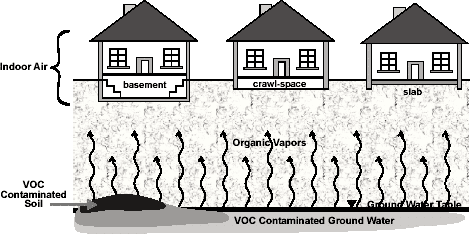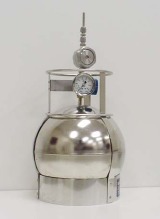|
Evaluating Indoor Air near VOC Contaminated SitesAlternate Format:
What are VOCs?Volatile organic compounds (VOCs) are a class of chemicals that readily evaporate at room temperature. Gasoline, dry cleaning fluid, degreasing agents (solvents) and paint thinners are several examples of products that contain these compounds. VOCs may be found in soil and/or ground water due to spillage onto the ground, leaks from underground storage tanks and other types of discharges. How VOCs in soil or ground water can affect indoor airIf VOCs contaminate soil or ground water at a site, it is important to evaluate nearby buildings for possible impacts from vapor intrusion. Vapor intrusion occurs when fumes from the contaminated soil or ground water seep through cracks and holes in foundations or slabs of buildings and accumulate in basements, crawl spaces or living areas, as shown in the diagram below. A variety of factors can influence whether vapor intrusion will occur at a building located near soil or ground water contaminated with VOCs. These include, but are not limited to, the concentration of the contaminants, the type of soil, the depth to ground water, the construction of the building, the condition of the foundation or slab and the existence of underground utilities, which can create pathways for vapors to travel. Short term exposure to high levels of organic vapors can cause eye and respiratory irritation, headache and/or nausea. Breathing low levels of organic vapors over a long period of time may increase an individual’s risk for respiratory ailments, cancer and other health problems. Organic vapors can be present inside a building at potentially harmful levels without being detectable by odor. Indoor air testing and other types of sampling are usually required to determine whether vapor intrusion is occurring at a property. Preparing for Indoor Air TestingIf your home or building is located near VOC contaminated soil or ground water, NJDEP or an environmental contractor may ask permission to test your indoor air. This will involve collecting a sample of the air and sending it to a certified laboratory to be analyzed for a wide range of VOCs. The purpose of the test is to look for VOCs from subsurface contamination. However, many materials and substances commonly found in commercial and residential settings, such as paints, paint thinners, gasolinepowered machinery, certain building materials and cleaning products, dry cleaned clothing and cigarette smoke, contain VOCs that may be detected by indoor air testing. Even VOCs from motor vehicle emissions and other outdoor sources can contaminate indoor air. When VOCs from these types of sources are detected during a vapor intrusion investigation they are referred to as background contamination. It is not always easy to tell whether VOCs detected inside a building are due to vapor intrusion, background contamination or a combination of both. Before undergoing indoor air testing, you will receive a copy of NJDEP’s Instructions for Occupants – Indoor Air Sampling Events. Following these instructions will help minimize background contamination and ensure the test results are as definitive as possible. Collecting Air Samples
To help evaluate possible impacts of background contamination on the sampling results, soil gas testing may be conducted concurrently with the indoor air testing. During soil gas testing, a sample of air from the soil beneath (or close to) the basement floor or slab is collected and analyzed for VOCs. If high levels of VOCs are detected by the soil gas testing and these compounds are also found in the indoor air, they are probably being caused by vapor intrusion and not background sources. Addressing Vapor IntrusionIf testing confirms vapor intrusion is causing potentially harmful levels of VOCs to accumulate inside a building, a subsurface depressurization system may be installed at the property. The system prevents vapors from entering the building by continuously venting the contaminated air beneath the basement slab or crawl space to the exterior of the structure. Subsurface depressurization systems are also used throughout the country to reduce levels of naturally occurring radon gas in buildings. See NJDEP’s fact sheet titled Subsurface Depressurization Systems for more information about how these systems work.
New Jersey Department of Environmental Protection April 2005
|
||||||||||||||||||||||||||||
| To report an environmental
incident impacting NJ, call the Toll-Free 24-Hour Hotline |
||
Contact DEP | Privacy Notice | Legal Statement & Disclaimers | Accessibility Statement |
||
Site Remediation Program: SRP
Home | About SRP |
Search | Help Copyright © State of New Jersey, 1996- |

